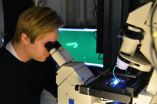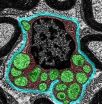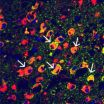(Press-News.org) This press release is available in German.
The unusual behavior of complex fluids is part of our daily life: cake dough climbs up the stirring bar, ketchup becomes liquid when you shake it. Also technology uses such phenomena: if we add a small amount of long-chained polymer molecules, a pipeline can transport more oil. The polymers reduce the flow resistance. But up to now the origin of these effects was unclear. The engineers had to rely on estimates and lengthy trials.
A team of physicists led by Professor Andreas Bausch, Chair of Cellular Biophysics at TUM now developed a numerical model of such liquids. Experimental heart of the work are a fine flow channel and a micro-camera. Like the camera looking down at the pit lane of Formula 1 races, the scientists monitored the movements of individual polymer molecules in the flow.
From their observations they conducted a theoretical model for the motion of rigid molecules different from the current. In addition, they were able also to provide for colleagues suspected of movement patterns experimental confirmation.
Challenging for theory and experiment
"Due to the incredibly large number of degrees of freedom the study and description of the motion of polymers is a big challenge," says Markus Harasim, one of the two main authors. Even a simple system of water and polymer shows the effects of complex fluids. In order to make the long molecules visible, the physicists marked the polymers with a fluorescent dye. This allowed them to study the movements under various conditions.
VIDEO:
The tumbling movements of the polymers contribute to the unusual behavior of complex fluids like ketchup, blood or paint.
Click here for more information.
To their surprise the mathematical modeling showed, that even the simple model of a stiff rod was suitable as a starting point. Then the researchers refined the model by taking into account the thermal motion, the flexibility of the molecule and the higher flow resistance of a curved polymer. "Since we now know the microscopic mechanisms, we can extend the model to more complex geometries and flows. And thanks to our experimental set-up we should be able to verify our theories," says co-author Bernhard Wunderlich, who is a well known rapper in the hip-hop band "Blumentopf" in his off time.
INFORMATION:
The work was funded by the German Research Foundation Center's research and the Cluster of Excellence Nanosystems Initiative Munich (NIM).
Publication:
Direct Observation of the Dynamics of Semiflexible Polymers in Shear Flow
Markus Harasim, Bernhard Wunderlich, Orit Peleg, Martin Kröger, and Andreas Bausch,
Physical Review Letters, online, 4. März 2013 DOI: 10.1103/PhysRevLett.110.108302
Link: http://link.aps.org/doi/10.1103/PhysRevLett.110.108302
Ketchup turns somersaults
Scientists develop a numerical model of complex fluids
2013-03-07
ELSE PRESS RELEASES FROM THIS DATE:
Mayo Clinic aids discovery of first dystonia gene found in African-Americans
2013-03-07
JACKSONVILLE, Fla. — A pair of studies tells the tale of how a neuroscientist at Mayo Clinic in Florida helped to discover the first African-American family to have inherited the rare movement disorder dystonia, which causes repetitive muscle contractions and twisting, resulting in abnormal posture. The research may improve diagnosis of this neurological condition in a population not known to suffer from it.
In the first study, published in 2011 in the journal Parkinsonism and Related Disorders, Mayo Clinic's Zbigniew Wszolek, M.D., and a team of neuroscientists from ...
Federal figures miss most work-related amputations
2013-03-07
A new report from Michigan State University and the Michigan Department of Community Health raises significant concerns about the federal government's system for tracking work-related injuries.
Published in the Journal of Occupational and Environmental Medicine, the study found the number of amputations following jobsite accidents in Michigan was nearly two-and-a-half times higher than the official estimate from the U.S. Bureau of Labor Statistics.
Such inaccuracy is evidence that the bureau should change its system that relies solely on a sample of employers to report ...
Protein lost in tumors blocks normal cells from being reprogrammed into stem cells
2013-03-07
Researchers from the Icahn School of Medicine at Mount Sinai have discovered that a particular protein prevents normal cells from being reprogrammed into cells that resemble stem cells, providing new insight into how they may lose their plasticity during normal development. This finding has broad-reaching implications for how cells change during both normal and disease development. The data are published this week in Nature Communications.
In a previous study, Emily Bernstein, PhD, and her team at Mount Sinai studied the natural progression of melanoma using mouse and ...
Researchers explain a key developmental mechanism for the first time in plants
2013-03-07
Cold Spring Harbor, NY -- The normal development of an animal or plant can be compared in at least two ways with the successful performance of a great symphony. The whole is the product of a great number of events involving contributions by many different "players"; and these contributions must occur in a precise and almost perfectly coordinated temporal and spatial sequence.
In simple animals like the fruit fly and more recently in plants and mammals, scientists have been able to identify some of the principal players in the developmental symphony. Today, a team ...
UTHealth researchers report prevalence of sexting among minority youth
2013-03-07
HOUSTON—(March 6, 2013)—Researchers at The University of Texas Health Science Center at Houston (UTHealth) have found that up to 30 percent of minority youths reported sending or receiving "sexts," which are sexually explicit messages sent through technology including photos, videos and text-only messages.
"Although sexting is relatively common among youth and there has been a lot of attention about sexting in the media, there hasn't been much about sexting among ethnic minority youth," said lead investigator Melissa Fleschler Peskin, Ph.D., assistant professor of behavioral ...
A sausage a day is too many
2013-03-07
This press release is available in German.
"We estimate that three percent of all premature deaths can be attributed to the high consumption of processed meat," summarizes Sabine Rohrmann from the Institute of Social and Preventive Medicine at the University of Zurich. Teaming up with research colleagues from ten countries, she has been studying the link between the consumption of processed meat and the risk of mortality as part of a Europe-wide study with around 450,000 participants.
People who eat a lot of processed meat such as sausage products, salami or ham ...
New clues to causes of peripheral nerve damage
2013-03-07
Anyone whose hand or foot has "fallen asleep" has an idea of the numbness and tingling often experienced by people with peripheral nerve damage. The condition also can cause a range of other symptoms, including unrelenting pain, stinging, burning, itching and sensitivity to touch.
Although peripheral neuropathies afflict some 20 million Americans, their underlying causes are not completely understood. Much research has focused on the breakdown of cellular energy factories in nerve cells as a contributing factor.
Now, new research at Washington University School of Medicine ...
Improving electronics by solving nearly century-old problem
2013-03-07
RIVERSIDE, Calif. (http://www.ucr.edu) — A University of California, Riverside Bourns College of Engineering professor and a team of researchers published a paper today that shows how they solved an almost century-old problem that could further help downscale the size of electronic devices.
The work, led by Alexander A. Balandin, a professor of electrical engineering at UC Riverside, focused on the low-frequency electronic 1/f noise, also known as pink noise and flicker noise. It is a signal or process with a power spectral density inversely proportional to the frequency. ...
Some brain cells are better virus fighters
2013-03-07
Viruses often spread through the brain in patchwork patterns, infecting some cells but missing others. New research at Washington University School of Medicine in St. Louis helps explain why. The scientists showed that natural immune defenses that resist viral infection are turned on in some brain cells but switched off in others.
"The cells that a pathogen infects can be a major determinant of the seriousness of brain infections," says senior author Michael Diamond, MD, PhD, professor of medicine. "To understand the basis of disease, it is important to understand which ...
Breaking the rules for how tsunamis work
2013-03-07
The earthquake zones off of certain coasts—like those of Japan and Java—make them especially vulnerable to tsunamis, according to a new study. They can produce a focusing point that creates massive and devastating tsunamis that break the rules for how scientists used to think tsunamis work.
Until now, it was largely believed that the maximum tsunami height onshore could not exceed the depth of the seafloor. But new research shows that when focusing occurs, that scaling relationship breaks down and flooding can be up to 50 percent deeper with waves that do not lose height ...
LAST 30 PRESS RELEASES:
NASA’s Webb telescope finds bizarre atmosphere on a lemon-shaped exoplanet
The gut bacteria that put the brakes on weight gain in mice
Exploring how patients feel about AI transcription
Category ‘6’ tropical cyclone hot spots are growing
Video: Drivers struggle to multitask when using dashboard touch screens, study finds
SLU research shows surge in alcohol-related liver disease driving ‘deaths of despair’
Rising heat reshapes how microbes break down microplastics, new review finds
Roots reveal a hidden carbon pathway in maize plants
Membrane magic: FAMU-FSU researchers repurpose fuel cells membranes for new applications
UN Member States pledge to increase access to diagnosis and inhaled medicines for the 480 million people living with COPD
Combination therapy shows potential to treat pediatric brain cancer ATRT
Study links seabird nesting to shark turf wars in Hawai‘i
Legal sports betting linked to sharp increases in violent crime, study finds
Breakthrough AI from NYUAD speeds up discovery of life-supporting microbes
New Eva Mayr-Stihl Foundation funding initiative boosts research at University of Freiburg on adaptation of forests to global change
The perfect plastic? Plant-based, fully saltwater degradable, zero microplastics
Bias in data may be blocking AI’s potential to combat antibiotic resistance
Article-level metrics would provide more recognition to most researchers than journal-level metrics
Satiety’s little helper: Protein that supports appetite regulating protein identified
UF dives deep into predicting storm damage with computer models
A stormy ocean voyage yields insights on the global carbon cycle
Scientists identify first non-coding gene that controls cell size
Demonstration of altermagnetism in RuO₂ thin films -- A new magnetic material for the AI era
Penn researchers awarded $25M to conduct trial using smartphones to fight heart disease
PCORI awards funding for new patient-centered healthcare research
Exploring the origins of the universe: 145 low-noise amplifiers complete ALMA telescopes
Empress cicada wings help illuminate molecular structure
Using sound waves to detect helium
Time burden in patients with metastatic breast and ovarian cancer from clinic and home demands
Researchers discover bias in AI models that analyze pathology samples
[Press-News.org] Ketchup turns somersaultsScientists develop a numerical model of complex fluids


